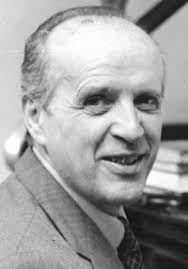THE SYMPHONIC MUSIC OF NINO ROTA

Nino Rota
Giovanni Rota Rinaldi
Born: December 3, 1911 – Milan, Kingdom of Italy
Died: April 10, 1979 – Rome, Italy
“He was someone who had a rare quality belonging to the world of intuition. Just like children, simple men, sensitive people, innocent people, he would suddenly say dazzling things. As soon as he arrived, stress disappeared, everything turned into a festive atmosphere; the movie entered a joyful, serene, fantastic period, a new life.”
Federico Fellini speaking of his long-time friend and collaborator.
Nino Rota began composing as a child, having composed an oratorio before his teen years, based on the theme of John the Baptist. At that point he began studying composition formally first at Milan Conservatory and then in Rome at the Academia Nazionale di Santa Cecilia. Later the conductor Arturo Toscanini referred Rota to Rosario Scalero at the Curtis Institute in Philadelphia, where he studied composition, as well as conducting with Fritz Reiner. Returning to Italy in 1932, Rota would produce many works including three symphonies, numerous concertos and ballet scores, as well as operas and works for chamber ensembles.
Rota composed 10 operas, 23 stage works and ballets, 3 symphonies, numerous concerti, chamber, and choral works. However, he was known internationally for his film music. From 1944 until his death in 1979 he scored 150 films. On an average he wrote 3 film scores a year but at the height of his career he managed to complete 10 scores in just one year!
It is, however, for his film scores that Rota is most well known having composed some 150 works in this genre. The collaboration between Italian film director Federico Fellini and Rota is one that lasted nearly three decades; beginning in 1951 with the film Losceicco bianco (The White Shark), and continuing with such films as La Strada (1954), La Dolce Vita (1960), and Amarcord (1973), among others.
Rota collaborated with other Italian directors, including Luchino Visconti and Franco Zeffirelli, as well as directors from France, Germany and Russia. The American director Francis Ford Coppola collaborated with Rota in the 1970s when producing the first two “Godfather” films, with the composer winning the Oscar for best score for the second film.
Symphony No. 2 in F Major (1937-41/rev. 1975)
La Tarantina – Anni di pellegrinaggio
The Symphony No. 2 in F Major wasn’t performed until 1975 (a year after The Godfather: Part II). The title, Year of Pilgrimage – Tarantina”, refers to the town of Taranto, in the Puglia region of southern Italy, to where Rota moved from Rome.
Rota was a master craftsman, effortlessly floating memorable themes over attractive counterpoint.
The symphony begins in a pastoral fashion followed by a tender song-like tune that pervades the entire movement. Rota’s irrepressible sense of humour comes to the fore, nevertheless, intermingling this song-like tune with a clever ‘Mahler-esque’ homage with a second theme reminiscent of a recurring thematic idea in Mahler’s early symphonies.
The second movement begins in a style somewhat reminiscent of Slavonic and Hungarian dance-style movements but eventually becomes increasingly lyrical.
The opening of the third movement brings the Tallis Fantasia to mind, though there is the added element of sombre brass. A tentative flute melody leads us out of the gloom, and the strings and brass provide some stirring climaxes before the sense of sadness and resignation returns.
By complete contrast, the finale is all lightness and humour.
The ADO’s performance is, incredibly, the Australian premiere of this marvellous symphony.
Variazioni Sopra un Tema Gioivale per orchestre (1953)
First performance New York Philharmonic 1957
Dedication: Fernando Previtali (Italian conductor, particularly associated with the Italian repertory, especially Verdi operas)
Proposta: Allegro Moderato Con Spirito
- Lo Stesso Tempo
- Il Tranquillo Scherzando
- Allegro Deciso
- Andante Cantabile
- Allegro Non Troppo
- Lo Stesso Tempo
- Alla Marcia, Allegramente
- Adagio
Finale: Allegro Con Fuoco, Vivacissimo
Rota explained that the term “gioivale” was not to be interpreted in the conventional sense of “jovial” but in a more basic association with the planetary body named for Jove (in English, Jupiter). As the Italian sources refer to it, “an attribute of Jupiter, the planet from which streams a river of serenity and contentment.” The eight variations are of diverse character: the first three are vivacious an spirited, the fourth romantic in mood. Numbers five and six are again animated, and sequentially related. For number sever Rota chooses a martial mood followed by a thoughtful and expressive variation eight. The work is brought to a climax in a finale which brings together various ideas fro the previous variations and concludes with the theme reprised “pomposamente.”
This performance by the ADO is also the Australian premiere.
